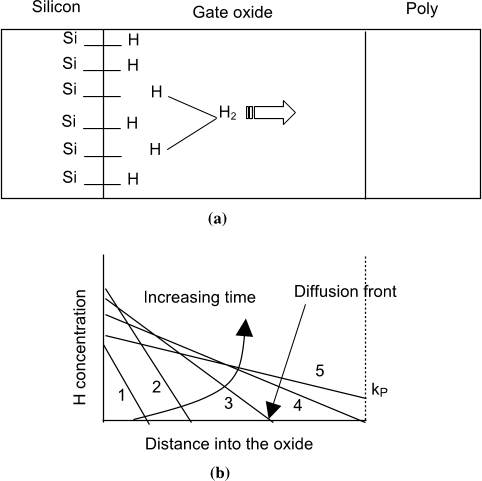Q2. What are the future works mentioned in the paper "A comprehensive model of pmos nbti degradation" ?
One of the key goal of their future work would be to clarify the role of such processing changes on NBTI performance.
Did you find this useful? Give us your feedback
![Fig. 5. Time evolution of (normalized) drain current shift for PMOS inversion and NMOS accumulation NBTI stress. Degradation at low VG for all time and high VG at shorter time is due to interface-trap generation, while long-time enhanced degradation at high VG is due to bulk-trap generation [15,16]. Under identical oxide field ðVGjinv ¼ VGjacc 1 V to account for difference in flatband voltage) PMOS inversion and NMOS accumulation (short time) stress show similar degradation, which characterizes the role of holes for NBTI.](/figures/fig-5-time-evolution-of-normalized-drain-current-shift-for-25rnsgi7.png)

![Fig. 7. Experimental and theoretical time evolution of threshold voltage shift data for a wide range of stress VG. The calculated bulk trap contributions are shown by dashed lines [15]. Theory matches well with experiment. Bulk trap generation at large oxide fields (high VG) affects overall threshold voltage shift and must be taken into account for properly estimating the forward reaction rate of the R–D model.](/figures/fig-7-experimental-and-theoretical-time-evolution-of-2fr9nut9.png)


![Fig. 9. Temperature activation of 1=tBREAK and DH. The DH is calculated from the universal scaling of temperature dependent (fixed oxide field) generated interface trap data. Obtained activation energy supports neutral H2 diffusion [32].](/figures/fig-9-temperature-activation-of-1-tbreak-and-dh-the-dh-is-2c3pb1to.png)


![Fig. 4. The R–D model is solved numerically for two cycles of interrupted stress (stress 1000 s, relaxation 1000 s). The simulation results (continuous line) agree well with measured data (symbols) [21]. The parameters used are kF ¼ 10 2/s, kR ¼ 10 18 cm3/s, N0 ¼ 1:24 1014/cm2 and TPHY ¼ 1:3 nm. Each 1000 s segment is characterized by a fast phase (first few seconds) followed by a slower phase of interface-trap generation, which relate to reaction-limited and diffusion-limited regimes, respectively.](/figures/fig-4-the-r-d-model-is-solved-numerically-for-two-cycles-of-hgnvx1j8.png)
![Fig. 3. Time evolution of threshold voltage shift of a 26 A PMOS during NBTI stress at 125 C [16]. The degradation rate is small initially but breaks off and increases at longer time. The break time and post-break slope are insensitive to oxide field (gate voltage), suggesting the long-time enhancement is not a bulk-trap activated process [15]. Such enhancement is anticipated by the R–D model (Section 2.2, Figs. 1 and 2). Absence of field acceleration of the breakpoint suggests neutral diffusion species.](/figures/fig-3-time-evolution-of-threshold-voltage-shift-of-a-26-a-3949uyl6.png)
460 citations
431 citations
...Firstly, oxide thickness was assumed to be infinite and the polysilicon was considered either as a reflector or absorber [1]....
[...]
373 citations
348 citations
...Numerical simulations have given values that are both somewhat larger [61] and smaller [63]....
[...]
...Another useful relation sometimes invoked in treatments of NBTI is the conservation rule [29,61,62]...
[...]
...According to some viewpoints, therefore, bulk positive charge generation is a separate process involving trapping of holes, not defect generation via a low-field reaction [61,65,79]....
[...]
...Another description of the effect of oxide thickness has claimed that the time dependence changes to t when the diffusion front of X reaches the gate electrode [61]....
[...]
...[50,63] Si–H + h M Si + H [61,63] Si–H þ hþ $ Si þ þ 2H2 [63] Si–H + hMSi +H [63,78] Si–H + H M Si + + H2...
[...]
347 citations
..., the gate voltages on n- and p-channel devices are not the same for a given oxide electric field [5]....
[...]
...In this paper, I will draw upon the excellent recent reviews by Stathis and Zafar [3], Huard et al. [4], and Alam and Mahapatra [5] as well as many other papers published in the last few years....
[...]
...[4], and Alam and Mahapatra [5] as well as many other papers published in the last few years....
[...]
2,610 citations
2,051 citations
1,033 citations
...2004 Published by Elsevier Ltd....
[...]
678 citations
...In this paper, we construct a comprehensive model for NBTI phenomena within the framework of the standard reaction–diffusion model....
[...]
673 citations
...In this paper, we construct a comprehensive model for NBTI phenomena within the framework of the standard reaction–diffusion model....
[...]
One of the key goal of their future work would be to clarify the role of such processing changes on NBTI performance.